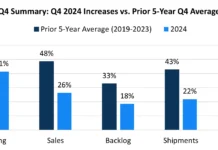by Todd M. Zielinski, CEO, and Lisa Benson, senior marketing content consultant, Athena SWC
In early 2020, when business-as-usual became a highly unusual labyrinth of challenges, rarely used words like essential, social distancing, quarantine and lockdown made headlines and littered everyday conversations. Not only did our vernacular change overnight, but the way we interact with each other changed, too, and closing the sale over face-to-face meetings, golf games and tradeshows became a memory. However, those plastics manufacturers that would remain healthy pivoted to change their sales strategies. For others, attracting new business became a serious challenge.
Bracing for 14 days to flatten the curve, we watched 14 weeks come and go, and before we knew it, 14 months had come and gone as well. We still have no end in sight as new virus variants pop up; vaccines are available, and boosters are being introduced, but for some, uncertainty lingers. Those manufacturers that have succeeded through it all have been flexible and adaptable to changing their sales strategies. These new sales strategies will likely shape the face of sales moving forward.
We’ve seen some tradeshows and in-person meetings start to return. Although many are eager to return to pre-pandemic ways, there is a lingering hesitancy for some toward unnecessary travel. Since the pandemic, we have seen the meaning of unnecessary travel slide on the scale a bit.
Meeting a prospect face-to-face in person was a necessary part of building relationships. You shook hands, looked each other in the eye, and maybe shared a meal. This is how trust was established and deals were made. Video conferencing was once thought of as a last resort, and for some manufacturers, it was a completely foreign concept. But companies quickly learned that to adapt, they needed to embrace the virtual world. For a while, the last resort became the only resort.
A large number of companies did adapt. A Wharton Business School survey of 352 chief marketing officers (CMOs) found that over 80% have increased their use of digital media, digital technologies to engage with customers and content creation such as videos and webinars.
Even so, there is an intense desire for many to get back to business and attend face-to-face meetings and events. However, with each state taking a different approach to deal with COVID spikes and many companies implementing their own requirements, manufacturers have to keep sales strategies nimble. The ability to meet face-to-face can be different from one company to the next or change from day to day as situations arise.
Connecting Virtually
The face-to-face selling model will always be the preferred sales method for many. Still, a virtual selling model will remain an important part of your business development arsenal for the foreseeable future.
When we talk about the virtual selling model, we are talking about video calls, sales webinars, virtual site tours, social selling (LinkedIn) and inbound marketing with search engine optimization (SEO). Moving forward, we will see more of a hybrid approach that combines the traditional face-to-face model with the virtual model with the flexibility to adapt strategies as necessary. For example, your first round of meetings with a prospect may be done remotely, but as you draw closer to having them make a decision, you may opt for an in-person meeting if possible.
Even if you are forced to meet remotely, during critical discussions, opt to have webcams on. While “Zoom fatigue” is something to be cognizant of with many businesses employing hybrid work-from-home policies, effective salespeople rely on facial expressions and body language to read their prospects and build trust, so using webcams is essential.
Increase Flow of Qualified Leads
In addition to having a nimble sales model, the pandemic further highlighted the critical need for a structured front-end sales process to maintain a steady flow of qualified leads through your sales pipeline. Harvard Business Review did a study that showed B2B companies with an effective pipeline process and trained salespeople managing it see 28% higher revenue growth, on average, over those with ineffective pipeline management.
A structured process includes many elements:
- Being selective with what types of prospects you allocate time and resources to
- Determining how many prospects you need to touch each month based on sales goals
- Understanding the steps in and length of your sales cycle as well as conversion rates for each step
- Content creation and SEO activities to drive inbound traffic
- Setting up a schedule for reaching out via phone calls, emails and even texts if that is the prospects preferred communication method
- Implementing a nurture program for prospects that aren’t quite ready
- Developing metrics to measure success
And an important step is follow-up. According to Michael Le Boeuf’s How to Win Customers and Keep them for Life:
- 44% of salespeople who ask for an order give up after one “no”
- 22% of salespeople who ask for an order give up after two “no’s”
- 14% of salespeople who ask for an order give up after three “no’s”
- 12% of salespeople who ask for an order give up after four “no’s”
But here is the kicker: 60% of customers will say no four times before saying yes. When a customer asks for you to follow up at a later date, be sure you do. Also, anticipate reasons they may say no and have a rebuttal ready. Ask questions and probe (gently) to understand what pains they are experiencing. Demonstrate how you can bring them real value; don’t rattle off a list of equipment or processes you have. If they say no today, maybe they will be open in six months or a year. Keep the lines of communication open.
Implementing a process for managing your prospecting activities also includes reviewing data to determine what has and hasn’t worked. This allows you to take necessary corrective actions. Treat your sales process like your manufacturing process; when you aren’t getting the expected result, implement corrective actions.
An important part of the process execution is the people. The right person should be doing the job that is right for their skill set. To be most effective, your salesperson should be working the sales funnel end – building relationships with fully qualified prospects and closing the sale.
All the activities higher up the funnel, such as lead generation and nurturing, should be performed by a team with the right skill set for each activity (research, warm-calling, content/graphics creation, email, RFQ/quote management, etc.). This is called division of labor – breaking down a process into separate tasks performed by those who are or will become specialized in that task. Account management shouldn’t be confused with sales. Selling to current customers (farming) requires a different skill set than creating new business from scratch (hunting).
Pulling It All Together
Even though the pandemic knocked us off balance temporarily, top-performing plastic manufacturers have demonstrated that flexibility and persistence pay off. Having a structured front-end sales process and readily adapting it to embrace a virtual sales model has helped them maintain focus and generate new business.
Todd M. Zielinski is managing director and CEO at Athena SWC LLC, and Lisa Benson is the company’s senior marketing content consultant. Athena provides a best-practice marketing process to help manufacturing companies with complex sales cycles increase qualified leads and sales pipeline revenue. For more information, visit www.athenaswc.com or email
tzielinski@athenaswc.com.





